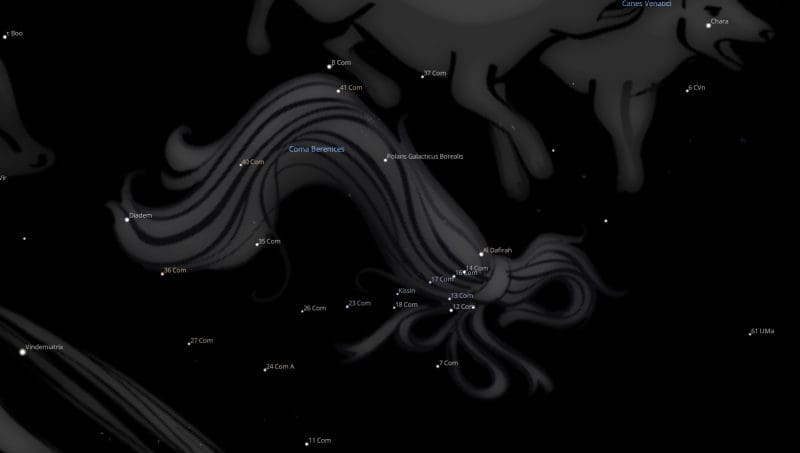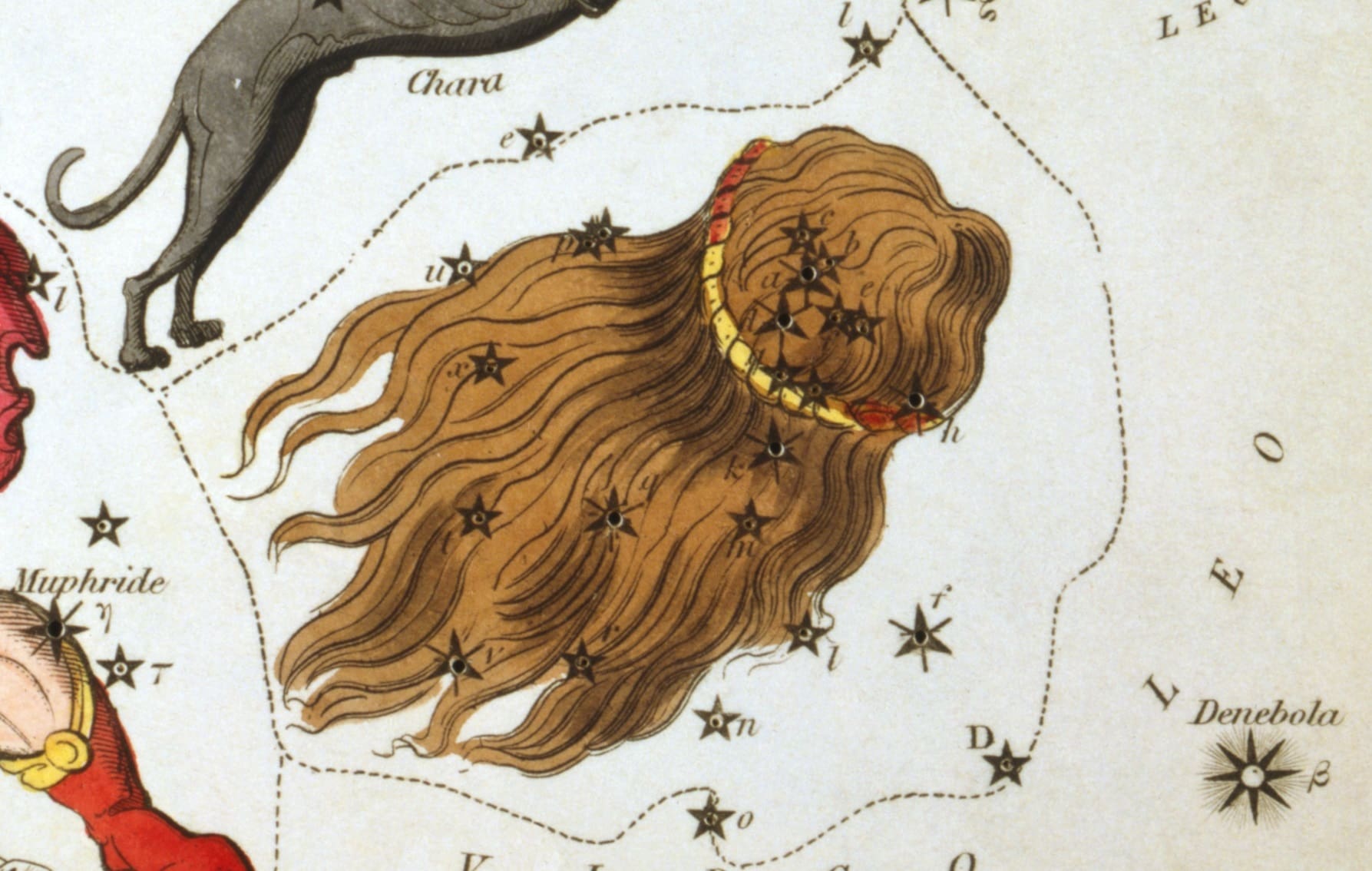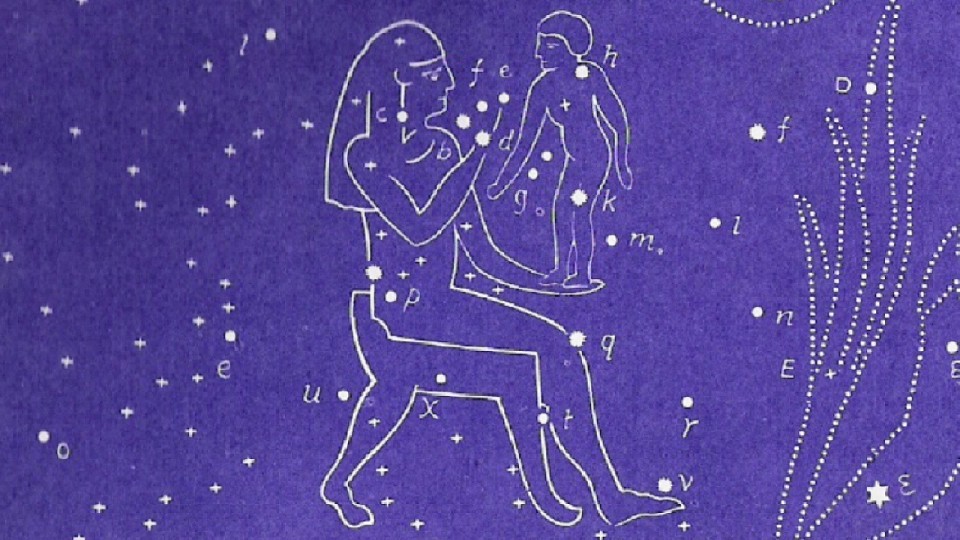FIXED STARS: Major Stars | 1000+ Stars | Constellations | About
Constellation Coma Berenices, Berenices Hair, is a northern constellation bordering Leo, Virgo, Boötes, Canes Venatici, and Ursa Major. It was introduced by Conon of Samos in third century BC and remains one of the 88 modern constellations. Coma Berenices spans 25 degrees of the zodiac in the Signs of Virgo and Libra.Coma Berenices Constellation Stars
| 2000 | 2050 | Star | Name | Sp. Class | Mag. | Orb |
|---|---|---|---|---|---|---|
| 22♍02 | 22♍44 | GK Com | Xìng Chén | K7 | 6.99 | 1°00′ |
| 23♍53 | 24♍36 | γ Com | Al Ḍafīrah | K2 | 4.35 | 1°10′ |
| 24♍06 | 24♍49 | 12 Com | F8 | 4.78 | 1°00′ | |
| 26♍39 | 27♍21 | 21 Com | Kissīn | A2 | 5.44 | 1°00′ |
| 27♍25 | 28♍08 | 11 Com | G8 | 4.72 | 1°00′ | |
| 28♍27 | 29♍09 | 23 Com | A0 | 4.80 | 1°00′ | |
| 29♍52 | 00♎35 | 31 Com | Lángjiāng | G0 | 4.93 | 1°00′ |
| 00♎06 | 00♎48 | 37 Com | K1 | 4.90 | 1°00′ | |
| 03♎24 | 04♎07 | 41 Com | K5 | 4.80 | 1°00′ | |
| 04♎21 | 05♎03 | β Com | G0 | 4.26 | 1°20′ | |
| 06♎24 | 07♎07 | 36 Com | M0 | 4.76 | 1°00′ | |
| 08♎57 | 09♎39 | α Com | Diadem | F5 | 4.32 | 1°10′ |
α Com is named Diadem, a type of crown. The name derives from the Greek διάδημα diádēma, “band” or “fillet”.
γ Com is named Al Dafirah, from the Arabic الضفيرة ađ̧-đ̧afīrah “the braid.”
31 Com is named 郎將 (Láng Jiàng, Captain of the Bodyguards). [1]
GK Com is named 幸臣 (Xìng Chén, Officer of Honour) [1]
Coma Berenices Astrology
The star Kissen in the Coma Berenices portends devastating rain. Fixed Stars and Judicial Astrology, George Noonan, 1990, p.43.
Robson
History and Legend. Added by Eratosthenes in A.D. 300. Berenice, the wife of Ptolemy Euergetes, offered up her hair to Venus on condition that her husband returned safe from the wars. The hair was placed in the temple but was stolen, and to appease the king’s wrath it was said that Venus had taken it into heaven to form a constellation.
Influence. It is said to give a suave and well-bred manner, with great personal charm, but to lead to an idle and dissipated life. There is some love of, or ability for the stage. Lilly states that the beginning of this constellation causes blindness or defective eyesight, and it is probable that the part lying in Virgo has some influence over baldness. [2]
Allen
It seems to have been first alluded to by Eratosthenes as Ariadne’s Hair in his description of Ariadne’s Crown… But for nearly 2000 years its right to a place among the constellations was unsettled… it was not known till about 243 B.C., in the reign of the 3rd (Euergetes), the brother and husband of Berenice, whose amber p169 hair we now see in the sky figure. It was the happy invention of this constellation by Conon that consoled the royal pair after the theft of the tresses from the temple of Arsinoë Aphrodite at Zephyrium. Some versions of the story turned the lady’s hair into a hair-star, or comet.
Manilius did not mention Coma… The Arabian astronomers knew Coma as Al Halbah, or Al Ḍafīrah, the Coarse Hair, or Tuft, in the tail of the Lion of the zodiac, thus extending that figure beyond its present termination at the star Denebola… Coma probably was known in early Egypt as the Many Stars.
The Chinese had several names here; the lucida being Hing Chin; u and w in the Reeves list, Chow Ting, the Imperial Caldron of the Chow dynasty; a small group toward Virgo, Woo Choo How; a, b, c, d, e, and f, Lang Wei, Official Rank; p, Lang Tseang, a General, and v, Shang Tseang, a Higher General; while Tsae Ching, the Favorite Vassal, was the title for Bode’s 2629. This abundant nomenclature, in so faint a figure, shows great interest on the part of the Chinese in this beautiful little group.
Although it is not easy for the casual observer to locate any of the individual stars except the lucida, three have been lettered — α, β, γ — that Baily claimed for Flamsteed’s 7, 15, and 23. Of these Fl. 15, an orange star, is generally supposed to be the Arabian Al Ḍafīrah, from Ulug Beg’s name for the whole that he located among the informes of Leo. Hyde cited some ancient codices as applying to Fl. 21, toward the south, the title Kissīn, a species of Ivy, Convolvulus (bindweed), or perhaps the climbing Dog-rose. [3]
Bullinger
“The first constellation in VIRGO explains that this coming “Branch” will be a child, and that He should be the “Desire of all nations.” The ancient name of this constellation is Comah, the desired, or the longed for. We have the word used by the Holy Spirit in this very connection, in Haggai 2:7–“The DESIRE of all nations shall come.”
The ancient Zodiacs pictured this constellation as a woman with a child in her arms. ALBUMAZAR (or ABU MASHER), an Arabian astronomer of the eighth century, says, “There arises in the first Decan, as the Persians, Chaldeans, and Egyptians, and the two HERMES and ASCALIUS teach, a young woman whose Persian name denotes a pure virgin, sitting on a throne, nourishing an infant boy (the boy, I say), having a Hebrew name, by some nations called IHESU, with the signification IEZA, which in Greek is called CHRISTOS.”
But this picture is not found in any of the modern maps of the stars. There we find today a woman’s wig! It appears that BERENICE, the wife of EUERGETES (PTOLEMY III), king of Egypt in the third century BC, when her husband once went on a dangerous expedition, vowed to consecrate her fine head of hair to Venus if he returned in safety. Her hair, which was hung up in the Temple of Venus, was subsequently stolen, and to comfort BERENICE, CONON, an astronomer of Alexandria (BC 283-222), gave it out that Jupiter had taken it and made it a constellation!
This is a good example of how the meaning of other constellations have been perverted (ignorantly or intentionally). In this case, as in others, the transition from ancient to more modern languages helped to hide the meaning. The Hebrew name was COMA (desired). But the Greeks had a word for hair, Co-me. this again is transferred to the Latin coma, and thus “Coma Berenice” (The hair of Berenice) comes down to us today as the name of this constellation, and gives us a woman’s wig instead of that Blessed One, “the Desire of all Nations.”
In this case, however we are able to give absolute proof that this is a perversion. The ancient Egyptian name for this constellation was Shes-nu, the desired son! The Zodiac in the Temple of Denderah, in Egypt, going back at least 2000 years BC, has no trace of any hair, but it has the figure of a woman and child.
Even Shakespeare understood the truth about this constellation picture, which has been so long covered by modern inventions. In his Titus Andronicus he speaks of an arrow being shot up to heaven to the “Good boy in Virgo’s lap.”
The constellation itself is very remarkable. Others contain one or two stars of the first or second magnitude, and then a greater or less variety of lesser stars; but this is peculiar from having no one very bright star, but contains so many stars of the 4th and 5th magnitudes. It contains 43 stars altogether, ten being of the 4th magnitude, and the remainder of the 5th, 6th, etc.” [4]
References
- List of Chinese star names – Wikipedia.
- Fixed Stars and Constellations in Astrology, Vivian E. Robson, 1923, p.39.
- Star Names: Their Lore and Meaning, Richard H. Allen, 1889, p.168-172.
- The Witness of the Stars, E. W. Bullinger, 1893, 1 I. Coma (the Desired).
[wp_ad_camp_3]


